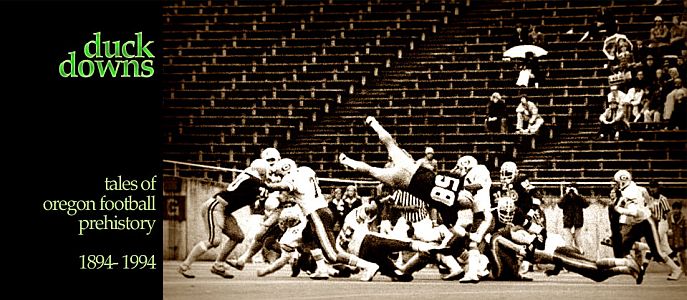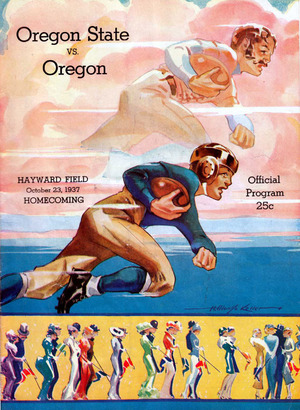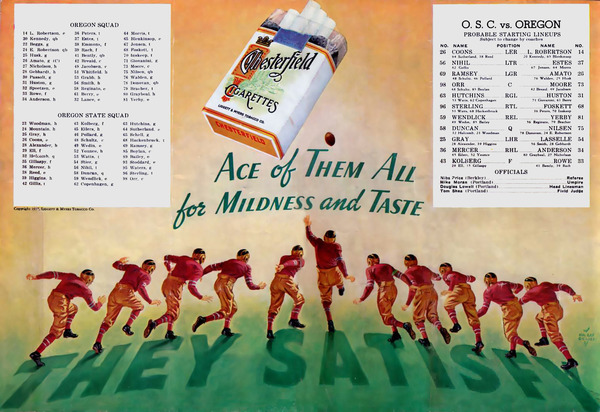« October 23, 1937: OSC at Oregon (Civil War) »
 August 23, 2011
August 23, 2011 The headlines screamed of scandal.
“VANDALS MAR HAYWARD FIELD TURF”, read the Register-Guard banner of October 22, 1937. “Letters O-S-C Burned in Sod.” Apparent retaliation for the “daubing of paint” on some Corvallis buildings, the vandals used heavy black crude oil to etch ten-foot block letters on Hayward Field’s newly restored grass. The hooliganism continued all weekend. (Monday’s headline: “OSC INVADES EUGENE: WAR FOLLOWS”.. “Well over 200 students from the State college were thrown into the icy waters of the mill race.” Oh, those nutty college kids.)
The program for the 1937 Civil War at Hayward Field – for some reason played at midseason, and won by the Aggies, 14-0, their second consecutive shutout of the Ducks and first win in Eugene in ten years – sports a lovely Lon Keller watercolor, contrasting the changes in styles between old-time and modern football and fashion. This is one of my favorite covers. (Keller, a renowned commercial artist who designed hundreds of college and high school program covers, is best known for designing the New York Yankees “bat-in-the-hat” team logo for the baseball club in 1947, still in use today. )
Content of the program continues to evolve. Tobacco advertising almost certainly helped cover the cost of the color pages. Unfortunately, other than the cover, all the color enclosed is used in tobacco advertising. The quantity of local advertising is significantly increased; clearly, this is a region emerging from the Great Recession. And, we start to see names that are familiar to modern readers, at least of a certain age – Eugene Farmers Creamery (then managed by Ken Kesey’s father Chuck, later Darigold), Northwest Cities Gas Co (now NW Natural) and Kennell-Ellis Photographers are still in business today.
Overall, it’s a few pages bigger, but the model of the 1930s-era programs holds: Some photos, a few paragraphs of text, and as many ads as can be sold.
- The hypesters were in fine form for the game preview. Apparently, OSC had “a combination of versatile sophomores who have literally ‘raised the devil’ in their performances this season.” (Literally? That must have been some halftime show.) There’s a posed action shot of OSC fullback Elmer Kolberg on page 9 that shows real style. But the rosters show that this was a pretty scrawny bunch of locals; Oregon had only three players weighing over 200 lbs in 1937, which likely contributed to the 4-6 record of Prink Callison’s last team of Webfoots.
- Pages 4 and 5 offer a grid that must have been fun to hand-letter (and that would be a real challenge now) – the score and opponent for every game ever played by Oregon. It’s a nice reminder that, a hundred years ago, the Webfoots absolutely ruled the military-industrial complex of the state of Washington.
- There are two ads for “Galli-Curci, the world’s best known soprano!” Amelita Galli-Curci was indeed a prima coloratura soprano, but by 1937 she was 55 years old, on the wrong side of laryngeal surgery, and well past her prime. It’s hard to imagine how she would have sounded in McArthur Court under modern conditions, but it can’t have been good under the circumstances. She apparently retired from the recital circuit shortly after this performance.








Reader Comments